

|
Solo Soundclip:
|
| See Steve's Hand-Written Solo transcription |
|
Michael Brecker's
solo on: From 1978-79, producer Tommy LiPuma was hired to handle Horizon Records, an imprint of A&M, where he brought along artists with whom he was already comfortable and in whom he believed, like: Brenda Russell, Seawind and Dr. John. As part of this new talent infusion was keyboardist Neil Larsen, who made two well-received albums for the label: "JUNGLE FEVER"(1978) and "HIGH GEAR"(1979). At the core of these recordings was Neil's longtime musical compatriot, the very special guitarist, Buzz Feiten. 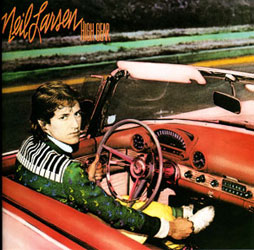 As a guest artist/sideman on "JUNGLE FEVER," the great Michael Brecker appeared on a few tracks, and contributed solos to tunes: "Emerald City" and "Last Tango in Paris." One year later, when it came time to record, "HIGH GEAR," Michael was on board again, and was the featured soloist on a couple more tunes. One of my personal favorite solos by Mike was on Neil's composition, "Demonette" which we are going to feature here. As a guest artist/sideman on "JUNGLE FEVER," the great Michael Brecker appeared on a few tracks, and contributed solos to tunes: "Emerald City" and "Last Tango in Paris." One year later, when it came time to record, "HIGH GEAR," Michael was on board again, and was the featured soloist on a couple more tunes. One of my personal favorite solos by Mike was on Neil's composition, "Demonette" which we are going to feature here.Filling out the rhythm section for "HIGH GEAR" was: Abraham Laboriel(El. Bass); Steve Gadd(Drums); and Paulinho Da Costa(Perc.). Though I could be completely wrong about this, it is my sense that Michael Brecker's solo was probably overdubbed. At the very least, because Mike was a New Yorker, and the album was recorded and mixed in Los Angeles by the none other than Al Schmitt. As I wrote a few days before the "Nile Crescent" analysis was officially posted in September, 2017 here at KORNER 1, I had reconnected with Buzz Feiten via e-mail, and he confirmed for me that Mike's solo was, in fact, overdubbed. Buzz and I worked together a lot during the mid-'70s, and it was an honor and a thrill to have played alongside him, as he has been a most inspirational player for me, and for countless others. To repeat myself, most of the time, if there are going to be overdubbed solos, one is counting on the drummer to use his imagination, and to "hear" an imaginary solo in his mind, and then react as if it had been really happening live. You can hear during the Brecker solo that Gadd plays some forceful figures as if he was interacting with a soloist. If everything stays on one level, dynamics, etc., it would never give the impression that it had all happened at once. No matter what, that's the impression that everyone is trying to create - and great players can do that! This particular tune has chord changes, and a form for the solo section. It's a 16-bar form with an 8-bar [A] section and an 8-bar [B] section. 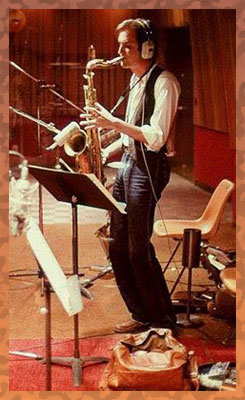 In total, Mike plays 3 choruses in cut-time, with the 3rd chorus having an added 4-bar [Tag] so that there is an opportunity for Mike's solo to have a graceful exit back into the main melody. Even though you can hear that Steve Gadd is playing one of his great mounted cowbell grooves on the drums, though undermixed in my opinion, I would describe the feeling of this groove as some kind of Samba Fusion. I wasn't certain that I should call it that, but after a phone conversation with my dear friend, saxophonist Rafael Greco in Caracas, Venezuela, he confirmed for me that this perception seemed to be the best description of what was going on from a rhythmic perspective. In total, Mike plays 3 choruses in cut-time, with the 3rd chorus having an added 4-bar [Tag] so that there is an opportunity for Mike's solo to have a graceful exit back into the main melody. Even though you can hear that Steve Gadd is playing one of his great mounted cowbell grooves on the drums, though undermixed in my opinion, I would describe the feeling of this groove as some kind of Samba Fusion. I wasn't certain that I should call it that, but after a phone conversation with my dear friend, saxophonist Rafael Greco in Caracas, Venezuela, he confirmed for me that this perception seemed to be the best description of what was going on from a rhythmic perspective.As always, this transcription is written in concert key, but transposed an octave up from where it sounds, as this is where one writes for the guitar. The tenor sax is actually written for one octave plus a whole-step above where it sounds. So, what you might be looking at is actually close in written register to what a tenor saxophonist actually sees. Here's hoping that this is not too confusing for those non-guitarists out there who are visiting these pages for the first time. For me, as a listener first and foremost, and as a fan of Michael Brecker, the key element to this particular solo is that it is just about being right in the center of the flow of the time feel and swingin' really hard! To these ears, there is not one single note in this solo that ventures outside the harmonies, not one! How rare is that for a Michael Brecker solo? There is hardly any chromaticism within the solo. How rare is that? It proves one thing at the very least, if you play with aggressive and swinging time, you can play anything and it's going to work - and, more than this, you can play completely inside and have a monster of a solo! See if you don't feel the same way about this solo over "Demonette." Now, let's get right to it! As Chorus 1 begins, and where the written transcription is concerned, you must remember that we are in cut-time and so, in a sense, you are ready twice as fast as compared to seeing the solo written in 4/4 and therefore seeing 16th-notes jammed into each bar. Mike begins his solo in bar 1, after Steve Gadd's crash on beat one, with a vaulting flurry in triplets up to a C#. As the chord for these first 8 bars, which I am calling letter [A], is Gmaj7#4, the correct mode for this should be G Lydian [G, A, B, C#, D, E, F#], but rather than approaching his playing over this sonority from a modal perspective, Mike plays everything by cutting down the notes by utilizing the F# minor 7 pentatonic [F#, A, B, C#, E] which gives you all of the important notes from within the mode and, the other huge plus, is that the flavor of your playing is always close to the blues. Theoretically, the key to using this minor pentatonic to produce Lydian sounds is that you play the minor pentatonic that is built from the major 7th degree of the Lydian mode. And, when you do this you are getting the following color tone degrees: maj7th, 9th, 3rd, #4, and the 6th. In other words, with these 5 notes, you are producing ALL of the color tones!!! If you notice, during the first 8 bars of this solo, Mike places a lot of emotional emphasis on the note C#(#4). To me, if this was being played over the more simple Gmaj7 and he wanted to blend in the #4, that same C#, most of us find it annoying to place so much weight on that note. It is like waving a flag and saying, "Hey! Look at me!!!" But, when playing, you don't want to or need to draw so much attention to any one particular note. However, what Mike is doing here is completely different and so the impact is powerful. You will also hear and see that, once again, he using the alternate fingering (+) technique to repeat those C#'s. This too adds to the power of the statement. 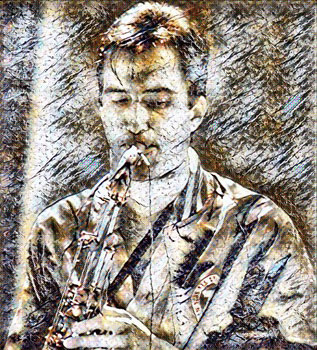 There's an interesting moment in bar 7, on beat 1, where I hear that he played a G#, which, of course, is outside the tonality. In all honesty, I think that this was possibly a mistake, perhaps it was supposed to have been an alternate fingering for another A-natural? But, this is what I heard, so, I have to point it out, even if it goes by so fast that you hardly notice it. There's an interesting moment in bar 7, on beat 1, where I hear that he played a G#, which, of course, is outside the tonality. In all honesty, I think that this was possibly a mistake, perhaps it was supposed to have been an alternate fingering for another A-natural? But, this is what I heard, so, I have to point it out, even if it goes by so fast that you hardly notice it.In the pick-up to bar 6, where this very characteristic 3-note grouping of A-E-B, with the 'honk' on that low B-natural being so much a part of Mike's style and the style of all the great post-Coltrane tenor saxophonists, that one small aspect often makes me feel like the tenor saxophone is the greatest instrument on this earth! So close to the human voice, and these gutturral low sounds just become so powerful, emotional, and when played with a short accent, they seem to propel any solo phrase forward. As a guitarist, this is just so remarkable to me, and very moving, and fills me with a kind respectful envy. As the first [B] section arrives, Larsen's tune brings on some chord changes, one per bar. It is interesting to note that the "chord change" in bar 1 of the section, simply goes from Gmaj7#4 to Gmaj7(9) and it still "feels" like a chord change. As Mike makes the change to F#m7, on beats 3-4 you find the first piece of chromaticism. In bar 3, with the arrival of Cmaj7, it fascinating to me that Mike ascends to a C-natural, when normally, believe it or not, the root is a note that you want to avoid on big beats because it tends to rub against the major 7th within the chord. And yet here, it sounds fine. Notice that he's using simple arpeggios to spell out this chord, and the Bm7 that follows. When the Gmaj7#4 chord returns in bar 5 of this section, Mike's emphasis shifts to an A-natural on the upbeats, as his phrasing becomes more syncopated. In the 1st bar of Chorus 2, Mike is finishing-up the phrase from the prior section with a short B-natural on the and-of-2, and though brief, he takes a nice breath on the last 2 beats of that bar. Then, in bar 2, his emotional emphasis returns to that same C# and the alternate fingerings (+), but this time he alternates the C#'s with A-naturals, also played with its alternate fingering. From a time perspective, a rhythmic perspective, notice how he's placing the emphasis on beats 1 and 3, the same as Steve Gadd's feel, and digging hard into the time. The descending minor pentatonic lines, culminate with his beautiful sounding low notes, an A-natural on the and-of-2 and a B-natural on the and-of-4 before taking another nice breath in anticipating of the coming bridge section. As [B] arrives, in bar 1 over the Gmaj7(9) sonority, Mike is still in the G Lydian mode via his usage of the F# minor 7 pentatonic, but with the arrival in bar 2 of F#m7, the line becomes more of an arpeggio and again, rhythmically syncopated to the upbeats. The sense of arpeggios continue through both the Cmaj7 and Bm7 chords, again notice how Mike chooses to use the root, a C-natural, while passing through the Cmaj7 chord. This time it's on an upbeat so it's going to rub less against the maj7th in the chord. As the Gmaj7#4 chord returns in bar 5 of the section, it is fascinating to note that Mike is drawing notes from B minor pentatonic [B, D, E, F#, A] which produces great color tones against any major 7th chord, and here, gives our ears a respite from all of the C#'s. Then, pay special attention to the nice breath he takes in bars 7-8 as he gears-up for his final chorus. From beat 4 of the preceding bar of the last section, he bends that note into the C# that begins Chorus 3, and yet again, that C# becomes the key note, emotionally speaking for the first 5 bars over Gmaj7#4, but this time with the added fury of triplets along with the alternate fingerings (+). Notice how beautifully Mike hits beat 1 of bar 5 right with Steve Gadd's crash cymbal! 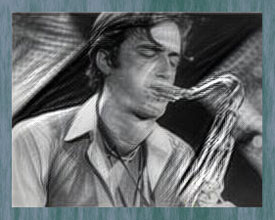 Bang!!! Then, in bar 6, he begins a syncopated climb into his upper, upper register culminating with a super high C#, a whole-step above the high B-natural that preceded it. That C# becomes the highest note that he played during both this solo and the one offered last month, "Nile Crescent." Bang!!! Then, in bar 6, he begins a syncopated climb into his upper, upper register culminating with a super high C#, a whole-step above the high B-natural that preceded it. That C# becomes the highest note that he played during both this solo and the one offered last month, "Nile Crescent."For the final [B] section of the solo, he plays a forceful long A-natural on beat 3 over the Gmaj7(9) chord, and then returns to chord tones over the F#m7 chord in bar 2. Again, over the Cmaj7, he plays a high C-natural, the root, on beat 1, but quickly gets off of it by bending it down to a B-natural. Probably a note that must have sounded better to his ears! In bar 4, of the section, over the Bm7 chord, there is. to me, still a sense of the blues or R&B as it feels like the 3 notes are drawn from B minor pentatonic [B, D, E, F#, A]. In bar 5, with the return of the Gmaj7#4 sonority, he plays a descending sequence of notes from the aforementioned F# minor pentatonic, but this time with more intervallic spacing between each 4-note sequential grouping: F#-E-B-F# to C#-B-F#-C#. Notice the 4ths intervals in the last 3 notes of each group. In bar 7, over the Am7 chord, he uses an arpeggio: E-G-B-D to surround the target note of the C-natural, the 3rd of the chord. But, it is all flying by so quickly, you would hardly notice it. Finally over the Gmaj7(9) chord in bar 8, we see the 2nd and final bit of chromaticism during this solo on beats 3-4, as Mike descends to a different target note of D-natural on beat 1 of the brief 4-bar [Tag] over the returning Gmaj7#4 chord. Here he plays a sequential phrase with the rhythmic emphasis on beats 1 and 3, going up a 5th, down a 4th, up a 6th, down a 5th, all in groups of 2 8th-notes with hard swinging long-short phrasing - and do not overlook that aspect, almost all swing comes from long-short phrasing. As Neil Larsen's buoyant melody returns, Mike holds over a nice low B-natural beneath it to close out this wonderful solo. As I was preparing this presentation, as I often do, I did some research and was saddened to find that these two wonderful albums by Neil Larsen were actually really hard to find. For example, at Amazon.com, and even iTunes, I didn't see mp3 versions readily available for each album. I found this really hard to believe, because my perception was that these albums were quite popular during their time. 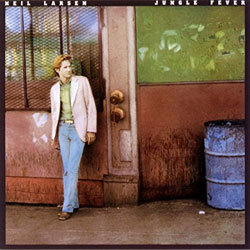 So, perhaps a little push from this piece might inspire the executives in charge to do something, and simply make these albums easily available to the public. If I may, here is a bit of information about the first album, "JUNGLE FEVER," which was recorded in 1978 with personnel that featured: Buzz Feiten(Guitar); Willie Weeks(El. Bass); Andy Newmark(Drums); Ralph MacDonald(Perc.); Michael Brecker(Tenor Sax); and Larry Williams(Alto Sax & Alto Flute) & Jerry Hey(Trumpet). Once again, engineered and mixed by Al Schmitt, there is great continuity in the recorded sound and audio presentation. So, perhaps a little push from this piece might inspire the executives in charge to do something, and simply make these albums easily available to the public. If I may, here is a bit of information about the first album, "JUNGLE FEVER," which was recorded in 1978 with personnel that featured: Buzz Feiten(Guitar); Willie Weeks(El. Bass); Andy Newmark(Drums); Ralph MacDonald(Perc.); Michael Brecker(Tenor Sax); and Larry Williams(Alto Sax & Alto Flute) & Jerry Hey(Trumpet). Once again, engineered and mixed by Al Schmitt, there is great continuity in the recorded sound and audio presentation.If you are new to all of this, and almost 40 years have passed as I sit here writing this, you would do well to investigate the past work that Neil Larsen and Buzz Feiten have done together. Though these albums might also be hard to locate, make the effort, because you never know what you might come-up with. Look no further than their album as "FULL MOON" from 1971. And then, the "LARSEN-FEITEN BAND" from 1980. As a guitarist, I can say with great confidence that some of Buzz' guitar solos contained on "FULL MOON" are just breathtakingly spectacular. You won't regret finding them. The solo on "The Heavy Scuffles On" is an absolute killer!!! Though I wrote this as the last analysis closed one month ago, I feel that it bears repeating here. It's a bit hard to believe, but this past January, 2017 marked the 10 year anniversary of the passing of Michael Brecker. I don't know what happened to the time. I often find myself getting upset when I can see that Jazz radio does not play Michael's recordings nearly enough. I just can't understand that. No matter what goes on, it is important to recognize the work of this great artist, and remind everyone that he must never be taken for granted. For those of us who were lucky enough to have known him as a friend, a bandmate, and colleague, he is missed every single day as he inspired us to go forward. My thoughts are always with his family, so to Randy, Emily, Susan, Jess, Sam, and Amanda, this little musical salute is dedicated to you.
[Photos: Michael Brecker @ the "JUNGLE FEVER" session, Photo by Blue Johnson courtesy of Louis Gerrits
Michael Brecker with Style® Jagged Treatment Michael Brecker with Style® Pencil Drawing Treatment] |